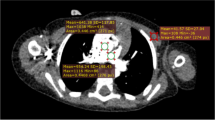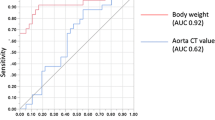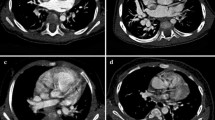Abstract
Background
Dual-source CT allows scanning of the chest with high pitch and high temporal resolution, which can improve the detection of proximal coronary arteries in infants and young children when scanned without general anesthesia, sedation or beta-blockade.
Objective
To compare coronary artery visibility between higher and standard temporal resolution.
Materials and methods
We analyzed CT images in 93 children who underwent a standard chest CT angiographic examination with reconstruction of images with a temporal resolution of 75 ms (group 1) and 140 ms (group 2).
Results
The percentage of detected coronary segments was higher in group 1 than in group 2 when considering all segments (group 1: 27%; group 2: 24%; P = 0.0004) and proximal segments (group 1: 37%; group 2: 32%; P = 0.0006). In both groups, the highest rates of detection were observed for the left main coronary artery (S1) (group 1: 65%; group 2: 58%) and proximal left anterior descending coronary artery (S2) (group 1: 43%; group 2: 42%). Higher rates of detection were seen in group 1 for the left main coronary artery (P = 0.03), proximal right coronary artery (P = 0.01), proximal segments of the left coronary artery (P = 0.02) and proximal segments of the left and right coronary arteries (P = 0.0006).
Conclusion
Higher temporal resolution improved the visibility of proximal coronary arteries in pediatric chest CT.





Similar content being viewed by others
References
Petersilka M, Bruder H, Krauss B et al (2008) Technical principles of dual source CT. Eur J Radiol 68:362–368
Tacelli N, Remy-Jardin M, Flohr T et al (2010) Dual-source chest CT angiography with high temporal resolution and high pitch modes: evaluation of image quality in 140 patients. Eur Radiol 20:1188–1196
Schultz B, Jacobi V, Beeres M et al (2012) Quantitative analysis of motion artifacts in high-pitch dual-source computed tomography of the thorax. J Thorac Imaging 27:382–386
Lell MM, May M, Deak P et al (2011) High-pitch spiral computed tomography: effect on image quality and radiation dose in pediatric chest computed tomography. Investig Radiol 46:116–123
Karlo C, Leschka S, Goetti RP et al (2011) High-pitch dual-source CT angiography of the aortic valve-aortic root complex without ECG-synchronization. Eur Radiol 21:205–212
Budoff MJ, Nasir K, Kinney GL et al (2011) Coronary artery and thoracic calcium on noncontrast thoracic CT scans: comparison of ungated and gated examinations in patients from the COPD gene cohort. J Cardiovasc Comput Tomogr 5:113–118
Beeres M, Schell B, Mastragelopoulos A et al (2012) High-pitch dual-source CT angiography of the whole aorta without ECG synchronization: initial experience. Eur Radiol 22:129–137
De Malherbe M, Duhamel A, Tacelli N et al (2012) Ultrafast imaging of the entire chest without ECG synchronization or beta-blockade: to what extent can we analyze the coronary arteries. Insights Imaging 3:73–79
Liu Y, Xu J, Li J et al (2013) The ascending aortic image quality and the whole aortic radiation dose of high-pitch dual-source CT angiography. J Cardiothorac Surg 8:228–232
Nakagawa J, Tasaki O, Watanabe Y et al (2013) Reduction of thoracic aorta motion artifact with high-pitch 128-slice dual-source computed tomographic angiography: a historical control study. J Comput Assist Tomogr 37:755–759
Han BK, Lindberg J, Grant K et al (2011) Accuracy and safety of high pitch computed tomography imaging in young children with complex congenital heart disease. Am J Cardiol 107:1541–1546
Paul JF, Rohnean A, Elfassy E et al (2011) Radiation dose for thoracic and coronary step-and-shoot CT using a 128-slice dual-source machine in infants and small children with congenital heart disease. Pediatr Radiol 41:244–249
Nie P, Wang X, Cheng Z et al (2012) Accuracy, image quality and radiation dose comparison of high-pitch spiral and sequential acquisition on 128-slice dual-source CT angiography in children with congenital heart disease. Eur Radiol 22:2057–2066
Tsai IC, Lee T, Chen MC et al (2007) Visualization of neonatal coronary arteries on multidetector row CT: ECG-gated versus non-ECG-gated technique. Pediatr Radiol 37:818–825
Ben Saad M, Rohnean A, Sigal-Cinqualbre A et al (2009) Evaluation of image quality and radiation dose of thoracic and coronary dual-source CT in 110 infants with congenital heart disease. Pediatr Radiol 39:668–676
Landis JR, Koch GG (1977) The measurement of interobserver agreement for categorical data. Biometrics 33:159–174
Rogalla P, Kloeters C, Hein PA (2009) CT technology overview: 64-slice and beyond. Radiol Clin N Am 47:1–11
Saake M, Lell MM, Rompel O et al (2014) Contrast medium application in pediatric high-pitch cardiovascular CT angiography: manual or power injector? J Cardiovasc Comput Tomogr 8:315–322
Goo HW, Yang DH (2010) Coronary artery visibility in free-breathing young children with congenital heart disease on cardiac 64-slice CT: dual-source ECG-triggered sequential scan vs. single-source non-ECG-synchronized spiral scan. Pediatr Radiol 40:1670–1680
Oberhoffer R, Lang D, Feilen K (1989) The diameter of coronary arteries in infants and children without heart disease. Eur J Pediatr 148:389–392
Arjunan K, Daniels SR, Meyer RA et al (1986) Coronary artery caliber in normal children and patients with Kawasaki disease but without aneurysms: an echocardiographic and angiographic study. J Am Coll Cardiol 8:1119–1124
Farshad-Amacker NA, Alkhadi H, Leschka S et al (2013) Effect of high-pitch dual-source CT to compensate motion artifacts: a phantom study. Acad Radiol 20:1234–1239
Achenbach S, Ropers D, Holle J et al (2000) In-plane coronary arterial motion velocity: measurement with electron-beam CT. Radiology 216:457–463
Husmann L, Leschka S, Desbiolles L et al (2007) Coronary artery motion and cardiac phases: dependency on heart rate — implications for CT image reconstruction. Radiology 245:567–576
Gao Y, Lu B, Hou Z et al (2012) Low-dose dual-source CT angiography in infants with complex congenital heart disease: a randomized study. Eur J Radiol 81:e789–e795
Klink T, Müller G, Weil J et al (2012) Cardiovascular computed tomography angiography in newborns and infants with suspected congenital heart disease: retrospective evaluation of low-dose scan protocols. Clin Imaging 36:746–753
Shi H, Aschoff AJ, Brambs HJ et al (2004) Multislice CT imaging of anomalous coronary arteries. Eur Radiol 14:2172–2181
Van Ooijen PMA, Dorgelo J, Zijlstra F et al (2004) Detection, visualization and evaluation of anomalous coronary artery anatomy on 16-slice multidetector-row CT. Eur Radiol 14:2163–2171
Young C, Xie C, Owens CM (2012) Paediatric multidetector row chest CT: what you really need to know. Insights Imaging 3:229–246
Nievelstein RAJ, van Dam IM, van der Molen AJ (2010) Multidetector CT in children: current concepts and dose reduction strategies. Pediatr Radiol 40:1324–1344
Davignon A, Rautahrju P, Boisselle E et al (1979) Normal ECG standards for infants and children. Pediatr Cardiol 1:123–131
Rijnbeek PR, Witsenburg M, Schrama E et al (2001) New normal limits for the paediatric electrocardiogram. Eur Heart J 22:702–711
Flohr TG, Leng S, Yu L et al (2009) Dual-source spiral CT with pitch up to 3.2 and 75 ms temporal resolution: image reconstruction and assessment of image quality. Med Phys 36:5641–5653
Conflicts of interest
Dr. Flohr is a Siemens employee who provided the research prototype enabling reconstruction of images with different temporal resolutions. His professional position had no influence on the results of this investigation, which was independently conducted by the radiologic and statistical departments of our university center.
Author information
Authors and Affiliations
Corresponding author
Appendix
Appendix
We reconstructed two sets of CT images from the same CT raw data, one with the standard reconstruction implemented on the dual-source CT scanner, the other with an off-line reconstruction using optimized temporal resolution, running on a separate PC.
For image reconstruction of the dual-source CT data acquired at pitch 2, an angular range of 180° of CT raw data per measurement system (in parallel geometry) are available for each image close to the isocenter of the CT scanner [33]. In the standard filtered back-projection reconstruction as well as when using the iterative reconstruction SAFIRE, all scan data available per image contribute to the final image, i.e. the full angular range of 180°. This type of image reconstruction, which we used to generate the first set of CT images, is beneficial for complete utilization of the applied radiation dose, but it is suboptimal with regard to temporal resolution. A scan data range of 180° corresponds to a temporal resolution of 140 ms at 0.28-s gantry rotation time. We obtained the second set of images with an alternative off-line reconstruction that uses only the minimum scan data range of 90° (in parallel geometry) per measurement system for each image. By doing so, only a sub-range of the available CT data contributes to each image. This approach is suboptimal with regard to dose utilization, but it provides images with the best possible temporal resolution of 75 ms. The method is fully equivalent to the image reconstruction that would have been used on the scanner if the scan data had been acquired at a higher pitch of 3.2. Reconstruction of both image datasets allows for an assessment of the effect of improved temporal resolution on the analyzability of coronary arteries.
Rights and permissions
About this article
Cite this article
Bridoux, A., Hutt, A., Faivre, JB. et al. Coronary artery visibility in free-breathing young children on non-gated chest CT: impact of temporal resolution. Pediatr Radiol 45, 1761–1770 (2015). https://doi.org/10.1007/s00247-015-3401-1
Received:
Revised:
Accepted:
Published:
Issue Date:
DOI: https://doi.org/10.1007/s00247-015-3401-1




